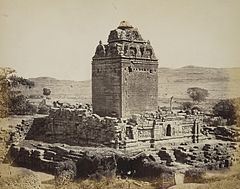Alternative names Gop Sun Temple Height 7 m Number of temples 1 | Type Temple Material Sandstone | |
 | ||
Designations ASI Monument of National Importance (N-GJ-133) Similar Gorthiya Mahadev Temple, Pimpleshwar Mahadev, Shri Swaminarayan Mandir - A, Shri Swaminarayan Mandir - B, Camp Hanuman Temple | ||
The ancient temple of Gop is located at Zinavari village of Jamjodhpur Taluka of Jamnagar district, Gujarat, India. It is dated 575-650 AD, one of the earliest surviving stone temples in Gujarat. It has Gandhara architecture influences and resemblances to north and south Indian temples. The temple has a square shrine surrounded by double courtyards. It has peculiar spire.
Contents
Location
It is located on the bank of Vartu river and south-west of the Gop hill of Barda Hills. There is a temple dedicated to Shiva known as Gopeshwar or Gopnath on the top of the hill. the caverns of the hill houses Hindu ascetics. The Zinavari village is also known as Juna or Nana Gop and is located east of Gop village. It is located north of Ghumli.
History
The ancient temple of Gop is considered the earliest surviving stone temple of Saurashtra as well as Gujarat. Its dating has been controversial among scholars. The most probable date considered now is the last quarter of 6th century (Maitraka period) to the first half of the 7th century but not earlier than Uparkot caves of Junagadh. The temple is protected monument by Archeological Survey of India and is designated as Monument of National Importance (N-GJ-133).
Legendarily, the temple is connected with Gopi and Krishna.
Architecture
The complex has a square shrine surrounded by double courtyards. The shrine is roofed by peculiar shikhara. The shrine is 10 feet 9 inches square from inside. It is 23 feet high and has 2 feet 6 inches thick walls. The walls are plain without any ornamentation and perpendicular to height till 17 feet and then it contracts to form a pyramid shaped shikhara. It is built of coursed ashlar. Each course is about 8 inches deep and is carefully jointed. Thus it is built without any kind of cement. At 11 feet from the floor, there are four holes in the front and back walls, each 14 inches high, as if for joists; and over them, in side walls, are six smaller holes, as if for rafters. The shrine door faces the east. The front wall over the wall had been fallen and rebuilt with the inner sides of the stones turned out, showing the sockets of the clamps with which the stones had been secured. There is an inscription on the left jamb of the door which can not be decipherable satisfactorily. It is probably local variation of Brahmi script.
The shikhara (spire) is formed by six or seven courses having beveled edges followed by square faces and at last the apex covered by single slab. It follows corbel principle, the interior is hollow. From outside, it rises in tires having three clear divisions. The lowest division has two chaitya-windows (dormer arches) on each side followed by upper division with single chaitya-window. The apex is crowned by a single stone with amalaka (stone disc) on it. These chaitya-windows had god figures. There is Ganesha figure still visible in the west side and another Deva figure on the north side. There is series of holes 2 1⁄2 feet below the string-course which supported beams that once supported the roof of inner courtyard.
Of two courtyards, the inner courtyard is mostly broken. It was 35 feet 2 inches square with bay on the east side 18 feet 4 inches by 7 feet 3 inches. It may have served as parikrama path so it is sandhara (with circumambulatory path) type of temple. The basement of it was decorated on all four sides by one niche in centre and one each at the corners. These niches contained most probably god figurine. The stretch between these niche was ornamented with small figures such as dwarfs. The outer courtyard was about 9 1⁄2 feet wide. It was probably open above or at least laterally.
There are two figures of deities in yellow stone inside the shrine. It can not be decided who are they exactly. They are locally known as Rama and Lakshaman. The Ram figure has high square Mukuta or head-dress while Lakshamana has low crown, long ear-rings, ringlets and holds spear in right hand. The figures are identified as Vishnu and Skandha by some historians. Some believe that it was dedicated to Surya, the solar deity. The location is connected with Shivaism also.
Influences and resemblances
The temple is an unusual architectural variation on the Nagara style. It has resemblances with early Dravidian temples of Pattadakal and Aihole. It also have similarities with temples of Kashmir in arrangement of roof and the trefoil niches on outside wall of inner courtyard. Such temples include Martand Sun Temple, Pandrethan and Payar temples though all of them are later than 8th century. The temple has influences of Gandhara architecture, the northwestern Indian tradition of the Kushana period, probably brought about to Kathiawar via Sindh by Buddhists which also influenced Kashmir architecture. Like Gupta period temples, the temple is on high and square plinth, jagati, with a projection on the east. But the plinth is much higher and is made of heavy blocks of stone which is characteristic local form. The temple has chaitya-windows similar to Uparkot caves of Junagadh but they had lost their use as vedika so they must have evolved later. The sculpture of Kahu-Jo-Darro stupa of Mirpurkhas has similarities with sculptures of Gop temple. As it is dated 4th to 5th century, the Gop temple may belonged to similar period. Based on polished red ware found around the temple, the temple may belonged to Western Satrap period. The radiocarbon dating of wood beam from the temple dating has confirmed its age of 550 AD.
